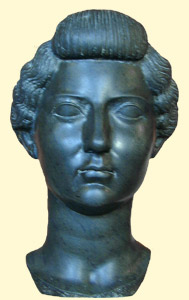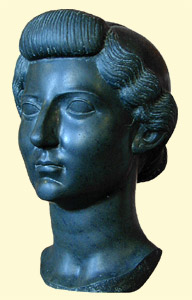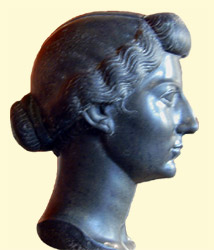This portrait head of Livia is made from basalt, a hard. black, volcanic
rock; this particular stone came from a quarry in Egypt, but that does not
necessarily mean that the portrait was carved there. The carefully carved face
is very distinctive and probably reflects aspects of Livia's actual appearance;
it is certainly the same type of face that appears on most of her portraits.
The head was designed to be inserted in a statue and probably dates from the
last quarter of the first century BCE.
This was a period when Octavian/Augustus was consolidating his power. He had
given unprecedented honors to his wife and his sister Octavia, who were both
presented as models of proper Roman womanhood. In this portrait Livia's
hairstyle is deliberately and emphatically Roman. Called the “nodus”
style (meaning knot or knob), it sweeps the hair back from the forehead in a
roll, which can be relatively tight or a loose wide knob, as here. This plain
and unadorned hairstyle evoked traditional Roman values, in contrast with the
more elaborate hairstyles that were becoming fashionable among aristocratic
Roman women of the time and especially with the exotic foreign queen Cleopatra.
Close this window when finished.




